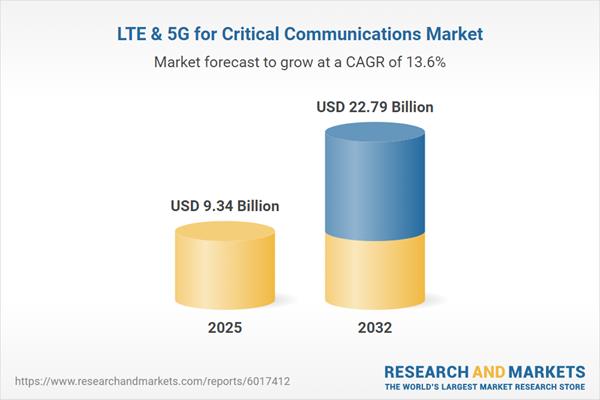Speak directly to the analyst to clarify any post sales queries you may have.
The LTE & 5G for Critical Communications Market is rapidly transforming how organizations in essential sectors deliver uninterrupted, secure digital communications. As industries prioritize system resilience and agility, advanced network solutions are now central to supporting business-critical operations.
Market Snapshot – LTE & 5G for Critical Communications Market
The global LTE & 5G for Critical Communications Market is experiencing robust expansion, moving from USD 8.21 billion in 2024 to USD 9.34 billion in 2025, with a projected value of USD 22.79 billion by 2032, at a CAGR of 13.61%. Growth is propelled by increasing investments from sectors such as public safety, utilities, transportation, and industry, all upgrading from legacy systems to modern broadband platforms. Organizations are driving demand for solutions that offer superior reliability, advanced security, and reduced latency, reflecting a widespread push for continuous, mission-critical connectivity.
Scope & Segmentation of the Market
This report provides senior decision-makers with an in-depth view of the global LTE & 5G for Critical Communications Market, segmenting it by technology, deployment, application, and key demographics to support strategic planning.
- Technology: Encompasses 5G in Non-Standalone and Standalone modes, network slicing, edge computing, and ongoing LTE deployments, all contributing to network agility and responsiveness for mission-critical use cases.
- Component: Examines devices such as handhelds, vehicle-mounted and wearables, available as LTE-Only or 5G-Enabled, alongside infrastructure components like fiber optic and microwave backhaul, core networking (5GC, EPC), and radio networks (Macro, Small Cells). It also addresses managed services including technical support and network management, as well as consulting and integration services.
- End-User Industry: Covers industries such as healthcare, mining, oil and gas, public safety, transportation, and utilities—each with unique compliance, performance, and continuity challenges in the deployment of critical communications.
- Deployment: Reviews hybrid networks (multi-operator, virtualized), private networks (campus and dedicated), and public networks (carrier-managed, MVNO) that allow flexible structuring to meet organization-specific operational and regulatory needs.
- Application: Includes data transmission, IoT services (eMTC, NB-IoT), video and voice communications, supporting mobile workforces and enabling uninterrupted operations in diverse conditions.
- Regions: Analyzes adoption and market innovation across the Americas (United States, Canada, Brazil, Mexico), Europe, Middle East, Africa, and Asia-Pacific, with attention to strategic growth in markets like China, India, Japan, and Australia.
- Key Companies Covered: Highlights industry leaders such as Motorola Solutions, Airbus Defence and Space, L3Harris Technologies, Thales, Nokia, Ericsson, Huawei, Hytera Communications, Sepura, and Tait Ltd., all shaping market direction and technology standards.
Key Takeaways for Senior Decision-Makers
- Organizations increasingly recognize integrated LTE and 5G networks as essential for ensuring reliable, business-critical communications and continuous operations.
- Emerging technologies like standalone 5G, network slicing, and edge computing deliver actionable, real-time data, enabling operational agility and supporting swift autonomous decision-making.
- Diverse deployment options, from private to public and hybrid solutions, offer customized network architecture to address compliance, security, and regulatory requirements in dynamic operational scenarios.
- The growing ecosystem of devices—from handhelds to vehicle-mounted and wearables—enhances front-line mobility and supports resilient collaboration in demanding environments.
- Competitive strategies now focus on partnerships, open architectures, and managed services to enhance system integration and accelerate the returns on advanced communications technology.
Tariff Impact: Navigating Trade and Policy Challenges
Recent tariff hikes in the United States affecting network component imports are increasing procurement costs within the critical communications sector. Industry responses include diversifying suppliers, renegotiating contracts, and expanding domestic manufacturing. As a result, organizations are tightening sourcing controls and improving inventory management practices, promoting greater supply continuity and policy compliance amid economic shifts.
Methodology & Data Sources
This report leverages primary insights from structured interviews and surveys with industry experts, complemented by secondary sources including industry reports, regulatory briefs, and market intelligence. Analytical frameworks such as SWOT analysis and scenario planning ensure the findings provide a rigorous, actionable foundation for decision-making.
Why This Report Matters
- Supports executives with a strategic roadmap for technology investment, operational transformation, and risk mitigation in the evolving LTE & 5G for Critical Communications Market.
- Offers practical recommendations and clear segmentation, empowering organizations to respond effectively to changing regulations, evolving supply chains, and new technologies.
- Enables tailored strategies for industries and geographies, helping organizations leverage connectivity advances while addressing regional market priorities.
Conclusion
This report equips senior leaders to optimize their communications strategy, enhance network resilience, and sustain operational excellence as digital transformation reshapes critical industries.
Additional Product Information:
- Purchase of this report includes 1 year online access with quarterly updates.
- This report can be updated on request. Please contact our Customer Experience team using the Ask a Question widget on our website.
Table of Contents
3. Executive Summary
4. Market Overview
7. Cumulative Impact of Artificial Intelligence 2025
Companies Mentioned
The companies profiled in this LTE & 5G for Critical Communications market report include:- Motorola Solutions, Inc.
- Airbus Defence and Space GmbH
- L3Harris Technologies, Inc.
- Thales S.A.
- Nokia Corporation
- Telefonaktiebolaget LM Ericsson
- Huawei Technologies Co., Ltd.
- Hytera Communications Corporation Limited
- Sepura plc
- Tait Limited
Table Information
| Report Attribute | Details |
|---|---|
| No. of Pages | 196 |
| Published | October 2025 |
| Forecast Period | 2025 - 2032 |
| Estimated Market Value ( USD | $ 9.34 Billion |
| Forecasted Market Value ( USD | $ 22.79 Billion |
| Compound Annual Growth Rate | 13.6% |
| Regions Covered | Global |
| No. of Companies Mentioned | 11 |









